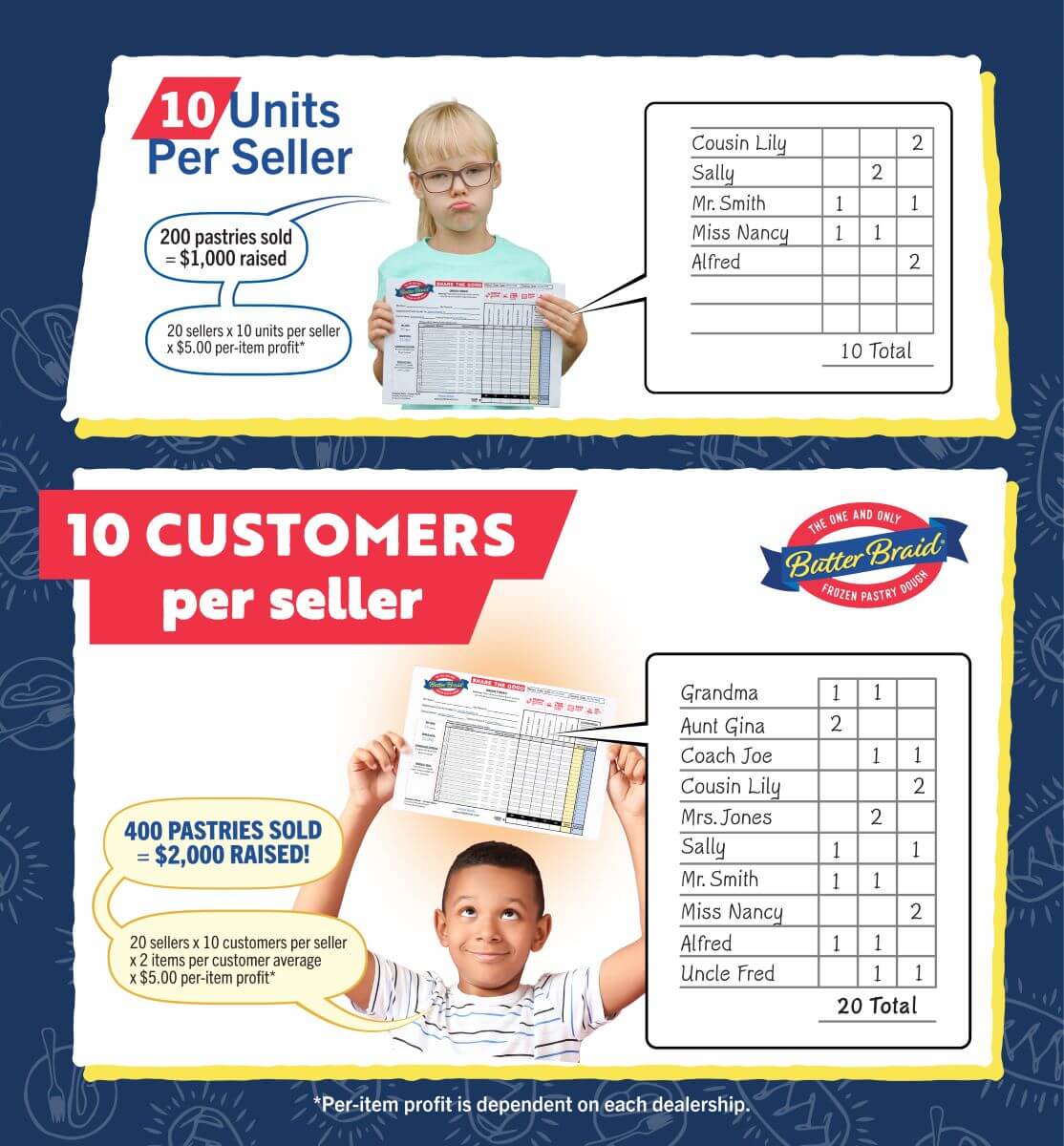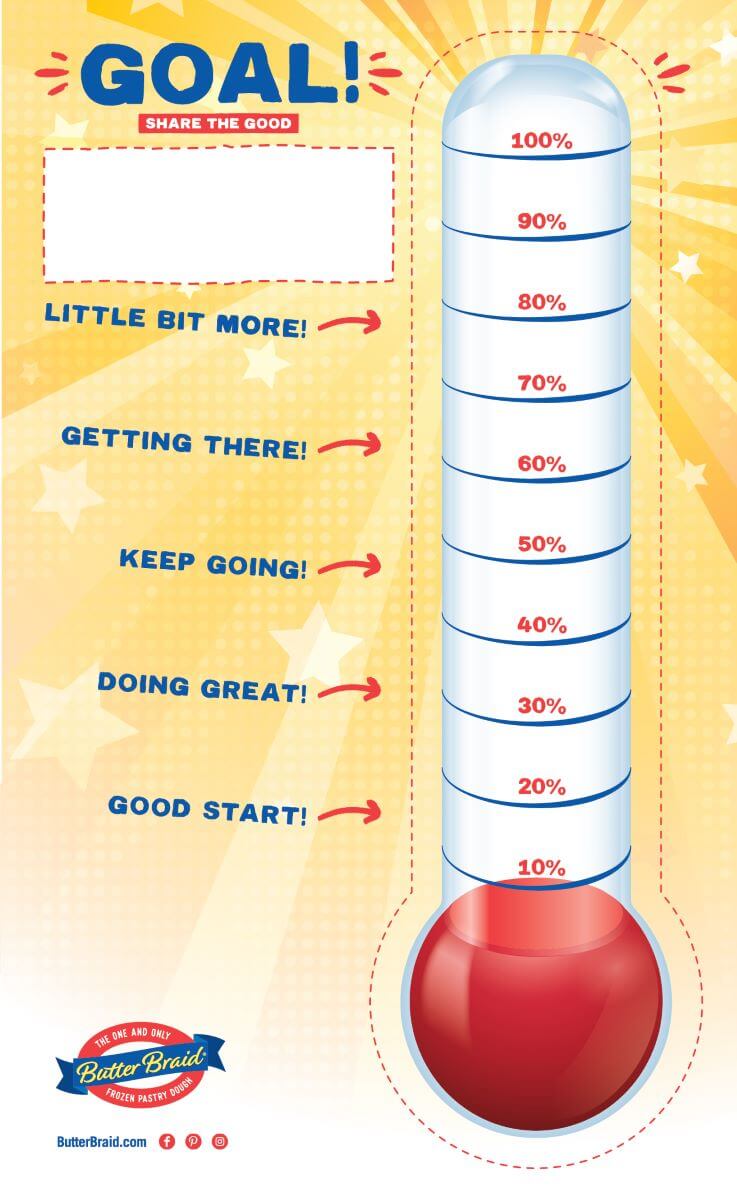In our Butter Braid® Fundraising programs, we stress the importance of setting individual goals for sellers. That’s because these types of goals can be a game-changer when it comes to achieving your group goal. While a larger, more ambitious group goal can seem daunting or even unreachable, breaking it down into individual, personal goals can make the challenge much more manageable and motivating. By focusing on these personal milestones, sellers not only contribute to the larger group goal but also gain a sense of personal accomplishment.
Providing your sellers with the right tools and strategies can help ensure they meet, and even exceed, their individual goal; thus, ensuring you achieve your group goal. In this post, we’ll explore some tips and tricks to help your sellers stay on track and help you maximize your fundraiser’s potential. So, what are you waiting for? Let’s get started!
Table of Contents
- What is an Individual Goal?
- Set SMART Goals
- Create a Personal Action Plan
- Keep Them Motivated
- Track Your Progress
- Provide Regular Feedback and Support
What is an Individual or Personal Goal?
An individual or personal seller goal in fundraising refers to a specific target set for each seller or participant to achieve during the fundraiser’s selling period. Rather than focusing solely on the total amount the group needs to raise, individual goals break that larger number down into manageable portions. These goals give each seller a clear and personal objective in order to make participating in the fundraiser more appealing and less overwhelming.
For example, let’s say your group’s overall goal is to raise $2,000. To reach that goal, you may decide that each seller should aim to get support from at least 10 customers. The “10 customers” represent their individual goal.
Tip: We encourage you to set individual goals based on the number of supporters they aim to reach rather than the number of units sold. This strategy offers two key benefits. Firstly, it challenges sellers to achieve a more difficult goal. Secondly, setting goals based on the number of supporters tends to increase the number of products sold per seller.

5 Tips and Tricks to Help Sellers Meet Their Individual Goals
1. Set SMART Individual Goals
When you’re ready to begin setting the individual goal for your sellers, we recommend using the SMART method. Setting SMART (Specific, Measurable, Achievable, Relevant, Time-Bound) goals is a powerful strategy for helping sellers achieve their individual fundraising targets. By breaking down what needs to be accomplished into clear, actionable steps, SMART goals provide a roadmap to set your sellers up for success.
- Specific: Start by defining exactly what you want to achieve. Instead of setting a vague goal like “sell a lot of items”, set a specific target such as “get a minimum of 10 people to support you”. This clarity helps sellers understand exactly what is expected of them and allows them to concentrate their efforts on a tangible objective.
- Measurable: Ensure the goal can be quantified so that progress can be tracked. Being able to measure progress helps maintain motivation and provides a sense of accomplishment as sellers see themselves getting closer to their goal.
- Achievable: Goals should be challenging but realistic. If a goal is too difficult, sellers may become discouraged. Conversely, if it’s too easy, they may not push themselves to their full potential. Consider your group’s experience, resources, and time availability when setting these goals.
- Relevant: The goal should align with the overall objectives of the fundraising campaign. A relevant goal ensures that efforts made by the seller is directly contributing to the success of the larger campaign. Simply put, the individual goal should directly support your mission.
- Time-Bound: Finally, set a deadline to create urgency and encourage consistent effort. Whether it’s reaching a weekly target or the final campaign deadline, having a time frame keeps sellers (and even supporters) focused and helps prevent procrastination.
2. Create a Personal Action Plan

Once you’ve figured out how many items each member of your group will need to sell, help set them up for success by working to create an action plan for each participant. A well-thought-out action plan gives sellers a clear direction, breaks down the tasks they need to accomplish, and helps them stay organized and motivated throughout the fundraising process.
First, help your sellers identify potential supporters to approach and plan how and when to reach out to them. For example, sellers can contact family members, friends, and neighbors first then expand their efforts to the broader community. If you need some tips to assist your group in finding potential supporters, check out our blog post Who Should You Sell To? Tips to Find Supporters for Your Next Fundraiser.
Tip: When working with your group on their action plan, remember to emphasize the importance of safety when fundraising. Remind them to…
- Never sell alone
- Don’t go into someone’s house
- Don’t sell after dark
- Avoid carrying cash when selling
In addition, the action plan should account for any obstacles or challenges that might arise. Provide your sellers with resources on how to ask people for their support. Furthermore, you’ll want to prepare them for what to do in case they hear a “no” to their request. Encouraging sellers to think about how they will handle rejection or a lack of response can help them stay resilient and keep moving forward. For younger sellers, it might be helpful to involve parents or guardians in the planning process to ensure they have the support they need.
3. Keep Them Motivated!

Maintaining motivation throughout the fundraising campaign is crucial for ensuring sellers stay engaged and committed to reaching their individual goals. While external rewards can be effective, there are many other ways to keep spirits high and encourage sustained effort without relying heavily on prizes or incentives.
One effective strategy is to regularly celebrate progress or milestones. Highlighting small victories, such as acknowledging when a seller reaches a particular number of items sold, can boost morale and reinforce the importance of each seller’s contributions. Public recognition via group/team meeting, social media post, or email shoutout can make sellers feel valued and even more inspired to help you meet your larger goal.
Additionally, fostering a sense of community and teamwork can be highly motivating. When sellers feel they are part of something bigger, they are more likely to stay committed. Encourage friendly competition or create opportunities for sellers to support each other. For example, organizing group check-ins where participants can share tips, experiences, and successes can create a positive atmosphere and strengthen camaraderie.
4. Track Your Progress

Keeping a close eye on your progress allows you to stay focused, make necessary adjustments, and maintain motivation throughout the fundraiser. It’s not just about seeing how far you’ve come; it’s about understanding what steps are still needed to reach your final goal.
One of the most effective ways to track your progress is by setting up a visual system for everyone to see. This could be a chart, graph, or even a simple checklist where you mark off each milestone achieved. Seeing your progress displayed visually can be incredibly motivating, as it provides a tangible representation of your sellers’ efforts.
Regularly reviewing your progress also allows you to identify any challenges or obstacles early on. If you notice that you’re falling behind, you can reassess your strategy and adjust to get back on track.
5. Provide Regular Feedback and Support
Regularly update your sellers on their progress, highlighting what they are doing well and areas for improvement. This feedback should be specific and constructive, offering clear guidance on how they can refine their approach or what they might need to focus more on. Acknowledging their hard work and progress can be a powerful motivator, helping them feel recognized and valued.
In addition to feedback, be sure to let your group know you are there to support them. You can do this by providing them with advice and additional resources or simply by being available to answer questions and address concerns. Make sure that sellers feel they can come to you when challenges arise. This makes a world of difference, especially for those who may be struggling or feeling uncertain about their ability to reach their goals.
Start Setting Individual Goals for Your Group Today!
Helping sellers meet their individual goals is key to the overall success of your fundraising efforts. By breaking down group objectives into manageable milestones, creating action plans, and maintain motivation through ongoing feedback and support, you empower each seller to meaningfully contribute to your cause. With these tips and tricks in place, your group will be well-equipped to hit their targets and make your next fundraiser a success.
Happy Fundraising!





